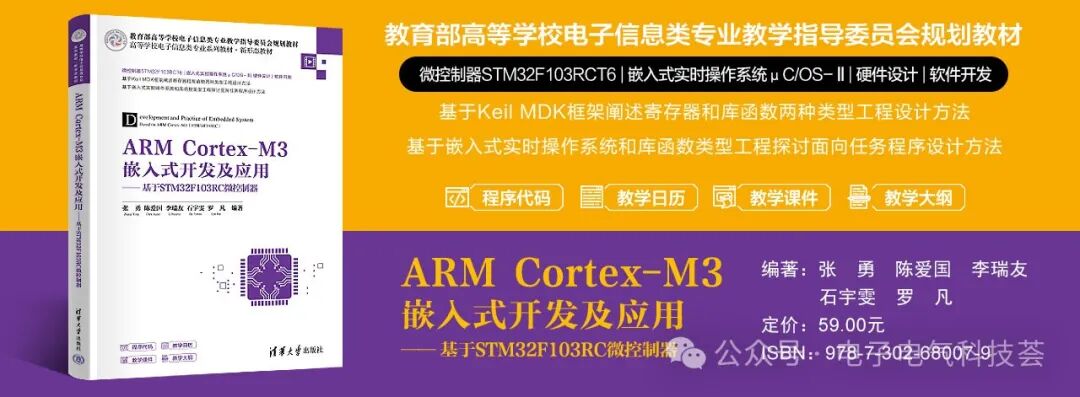
 Table of Contents
Table of Contents
Part 1: STM32F103 Hardware System and Keil MDK Project
Chapter 1: Overview of Embedded Systems
1.1Examples of Embedded Systems
1.2Concept of Embedded Systems
1.2.1Relationship between Embedded Systems and ARM
1.2.2Relationship between Embedded Systems and Embedded Operating Systems
1.2.3Characteristics of Embedded System Development
1.3Development History and Application Fields of ARM
1.3.1History and Naming Rules of ARM
1.3.2ARM Microprocessor Series
1.3.3Application Fields of ARM Microprocessors
1.4Embedded Operating Systems
1.4.1Windows CE
1.4.2VxWorks
1.4.3Embedded Linux
1.4.4Android System
1.5μC/OS-II and μC/OS-III
1.5.1Development History of μC/OS
1.5.2Characteristics of μC/OS-II
1.5.3Characteristics of μC/OS-III
1.5.4Application Fields of μC/OS
1.6Summary
Exercises
Chapter 2: STM32F103 Microcontroller
2.1Overview of STM32F103
2.2Pin Definitions of STM32F103RCT6
2.3Architecture of STM32F103
2.4Memory of STM32F103
2.5On-chip Peripherals of STM32F103
2.6Exceptions and Interrupts of STM32F103
2.7Summary
Exercises
Chapter 3: STM32F103 Learning Platform
3.1Core Circuit of STM32F103RCT6
3.2Power Circuit and Key Circuit
3.3LED and Buzzer Driver Circuit
3.4Serial Communication Circuit
3.5Flash and EEPROM Circuit
3.6Temperature Sensor Circuit
3.7Reset Circuit, JTAG, and ADC Circuit
3.8ZLG7289B Circuit
3.9LCD Screen Interface Circuit
3.10Codec Circuit
3.11Reference Circuit Board
3.12Summary
Exercises
Chapter 4: LED Control and Keil MDK Project Framework
4.1General Input/Output Ports of STM32F103
4.1.1GPIO Registers
4.1.2AFIO Registers
4.2Usage of STM32F103 Library Functions
4.3Keil MDK Project Framework
4.4LED Blinking Example
4.4.1Register Type Project Example
4.4.2Library Function Type Project Example
4.5Summary
Exercises
Chapter 5: Key and Interrupt Handling
5.1Working Principle of NVIC Interrupts
5.2GPIO External Input Interrupts
5.3User Key Interrupt Example
5.3.1Register Type Project Example
5.3.2Library Function Type Project Example
5.4ZLG7289B Key, LED, and Seven-Segment Display
5.4.1Working Principle of ZLG7289B
5.4.2Register Type Project Example
5.4.3Library Function Type Project Example
5.5Summary
Exercises
Chapter 6: Timers
6.1System Tick Timer
6.1.1Working Principle of System Tick Timer
6.1.2System Tick Timer Example
6.2Watchdog Timer
6.2.1Working Principle of Window Watchdog Timer
6.2.2Window Watchdog Timer Register Type Example
6.2.3Window Watchdog Timer Library Function Type Example
6.3Real-Time Clock
6.3.1Working Principle of Real-Time Clock
6.3.2Real-Time Clock Register Type Example
6.3.3Real-Time Clock Library Function Type Example
6.4General Timer
6.4.1Working Principle of General Timer
6.4.2General Timer Register Type Example
6.4.3General Timer Library Function Type Example
6.5Summary
Exercises
Chapter 7: Serial Communication and Codec
7.1Working Principle of Serial Communication
7.2STM32F103 Serial Port
7.3Serial Communication Register Type Example
7.4Serial Communication Library Function Type Example
7.5Codec
7.5.1Working Principle of Codec
7.5.2Codec Register Type Example
7.5.3Codec Library Function Type Example
7.6Summary
Exercises
Chapter 8: ADC and Memory Management
8.1STM32F103RCT6 Microcontroller ADC
8.1.1Working Principle of ADC
8.1.2ADC Project Example
8.2EEPROM Memory
8.2.1Accessing EEPROM Register Type Example
8.2.2Accessing EEPROM Library Function Type Example
8.3Flash Memory
8.3.1STM32F103 Synchronous Serial Port
8.3.2W25Q64 Access Control
8.3.3Accessing Flash Memory Register Type Project Example
8.3.4Accessing Flash Memory Library Function Type Project Example
8.4Summary
Exercises
Chapter 9: LCD Screen and Temperature Sensor
9.1Principle of LCD Screen Display
9.2Temperature Sensor
9.3LCD Display Example
9.3.1Register Type Example
9.3.2Library Function Type Example
9.4Summary
Exercises
Part 2: Embedded Real-Time Operating System μC/OS-II
Chapter 10: μC/OS-II System and Porting
10.1Porting μC/OS-II System
10.2μC/OS-II System Structure and Configuration
10.3μC/OS-II System Tasks
10.3.1Idle Task
10.3.2Statistics Task
10.3.3Timer Task
10.4Summary
Exercises
Chapter 11: μC/OS-II Task Management
11.1μC/OS-II User Tasks
11.2μC/OS-II Multi-task Project Example
11.3Statistics Task Example
11.4System Timer
11.5Summary
Exercises
Chapter 12: Semaphores and Mutexes
12.1μC/OS-II Semaphores
12.2μC/OS-II Mutexes
12.3Semaphore and Mutex Examples
12.4Summary
Exercises
Chapter 13: Mailboxes and Message Queues
13.1μC/OS-II Mailboxes
13.2μC/OS-II Message Queues
13.3Mailbox and Message Queue Examples
13.4Summary
Exercises
References
Purchase Link
